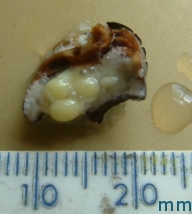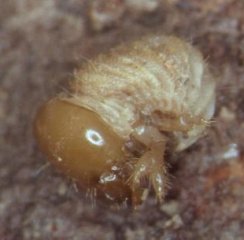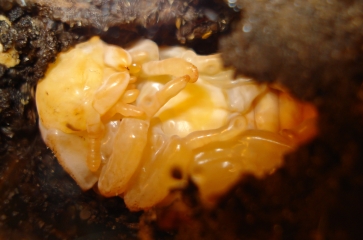 Identification
Identification
At an impressive and conspicuous five centimetres in length from tip of mandible to tip of abdomen, male specimens of this dark brown and black beetle have been recorded as the largest native terrestrial beetle found in Great Britain. They grow to about 8cm, but usually about 5 cm. Physical size and the magnificently antlered mandibles are therefore a good guide to the identification of this species when specimens are of this gender, although the female is only around three and a half centimetres in length with much smaller mandibles.
The size of both sexes varies considerably, such variety amongst other wood-boring insects being normal due to differences in the nutritive properties of the various trees upon which larvae feed (Imms, 1971).
Eggs 12 to 24 laid in next to rotting wood. The female may take a long time carefully preparing her nursery, digging around, chewing pieces of wood, and compacting them near the dead wood. As each egg is laid she uses her retractable ovipositor to form a hollow around it, exactly like some dung and burying beetles do.
12 to 24 laid in next to rotting wood. The female may take a long time carefully preparing her nursery, digging around, chewing pieces of wood, and compacting them near the dead wood. As each egg is laid she uses her retractable ovipositor to form a hollow around it, exactly like some dung and burying beetles do.
Larva Stag Beetle larvae are blind and shaped like a letter "C". They feed on rotting wood in a variety of places, tree stumps, old trees and shrubs, rotting fence posts, compost heaps and leaf mould. The larvae have a cream coloured soft transparent body with six orange legs, and an orange head which is very distinct from the very sharp brown pincers. They have combs in their legs which they use for communication (stridulation) with other larvae.
Stag Beetle larvae are blind and shaped like a letter "C". They feed on rotting wood in a variety of places, tree stumps, old trees and shrubs, rotting fence posts, compost heaps and leaf mould. The larvae have a cream coloured soft transparent body with six orange legs, and an orange head which is very distinct from the very sharp brown pincers. They have combs in their legs which they use for communication (stridulation) with other larvae.
Instar The stage in an insect's life history between two moults. When a stag beetle larva first comes out of the egg it is in his first instar (L1). This tiny freshly hatched larva has a rigid head so, in order to grow, it has to shed its skin by moulting. This way the second instar (L2) is the larva after the first moult; the third instar (L3) is the larva after the second moult.Usually stag beetle larvae are expected to reach their third instar before the start of their first winter, and after that will spend a long time fattning up before they are ready to pupate. Very interestingly it was found that with stag beetles reared in captivity a fifth or even a sixth instar might happen
The stage in an insect's life history between two moults. When a stag beetle larva first comes out of the egg it is in his first instar (L1). This tiny freshly hatched larva has a rigid head so, in order to grow, it has to shed its skin by moulting. This way the second instar (L2) is the larva after the first moult; the third instar (L3) is the larva after the second moult.Usually stag beetle larvae are expected to reach their third instar before the start of their first winter, and after that will spend a long time fattning up before they are ready to pupate. Very interestingly it was found that with stag beetles reared in captivity a fifth or even a sixth instar might happen
Picture shows the third instar
weight - 21.5 g , length - 8 cm
Between three and six weeks during the summer inside a cocoon, in the soil, made of compacted soil. In the wild prepupation gets well under way before the end of July.
female stag beetle pupa
Adult stag beetle
The adult stab beetle may stay inside the cocoon or not. In any case it will always remain under the ground for several months until it emerges in the summer to fly outside.
source : www.biodiversitysussex.org , www.websters-online-dictionary.org , maria.fremlin.de


No comments:
Post a Comment